How to cover a wooden floor: varnish, oil or wax? + work technology
Wooden elements in the interior design bring a sense of home comfort and warmth to it. In addition, natural wood always looks expensive. No matter what new items appear on the construction market, a tree will never go out of fashion. An increasing number of people when choosing flooring prefers the most environmentally friendly of them. And what could be more natural than wood. Such a floor has excellent thermoregulation: it will always be warm in cold winters, and cool in summer heat. It is pleasant to walk barefoot along it, and with proper care, it will serve you for many years. It is the need for care that is probably the only drawback of the wooden floor. But it can also be easily eliminated, the main thing to know is how to cover a wooden floor in order to avoid unnecessary trouble.
So, in your house or apartment a wooden floor. Where to start processing it? With the choice of material, of course. For quite a while, the most common coating for a wooden floor was ordinary oil paint, often not the most pleasant color. And only in recent years have coatings become popular that do not hide the texture of the tree, but only give it a more saturated shade and gloss. As a rule, these products also protect wood from the negative effects of the environment. The choice of such coatings is quite large - all kinds of varnishes, mastics, oils, wax and so on.
Content
Preparatory stage
New floor
If you have installed new boards, first of all you need to check how deeply recessed nails and screws. Hats should be pressed a couple of millimeters into the surface of the board. Then these same hats must be covered with sealant or putty on wood.
The color of the material should match the color of the wood as best as possible. Now we cover the floor with the starting varnish and leave to dry. Drying time depends on how dry the boards you used. If the moisture content of wood is more than 12%, it needs to be dried for a sufficiently long time - 3-4 months. In this case, the primary treatment is best done in the autumn, and then leave the floor to dry until spring. In the case when dried boards were used for laying the floor, it is enough to wait 2-3 weeks.
Old floor
Quite often, owners of Soviet-built apartments or old houses with painted wooden floors, succumbing to the desire to update the flooring, are surprised to find that the boards are still in excellent condition. In such a situation, only a few layers of paint separate you from the coveted wooden floor with a natural texture. How to remove this very paint? The process is quite simple, but laborious. Although, if you manage to find a looping machine with a bag for collecting dust - everything will be much simpler.
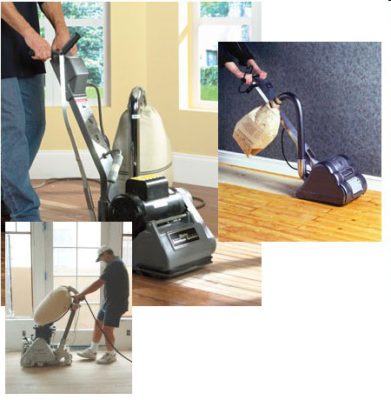
Buying such a unit for single use is impractical, but if you manage to rent or ask friends, it will greatly facilitate your work. You can also contact the construction company, which provides services for the cycling of floors.
If for some reason you decide to do without the help of special equipment, you will need the following tools:
- Iron, preferably old;
- A lot of paper;
- Paint remover (rinse);
- A few spatulas and a sharp knife;
- Power Planer;
- A grinder with a grinding nozzle for wood;
- Sandpaper with a grain size of 150-180.
First you need to remove the old paint. To do this, put a sheet of paper on the floor, and a hot iron on it. Under the influence of temperature, the paint lags behind the floor and sticks to the paper. What remains on the floor, remove with a knife or spatula. In places where the paint is eaten into the wood - use a wash.
After the floor is cleaned, it is necessary to remove the top layer of the boards with the help of an electric planer, after making sure that the nail heads do not protrude above the floor surface. When working with the electric plane, be sure to wear a respirator.
Using a grinder with a grinding nozzle and sandpaper we give the floor the necessary smoothness. But the dust remaining after grinding must be collected - it will come in handy.
Now you need to putty the joints between the boards and possible flaws in the wood. To do this, you can use a wood-based putty that is suitable in color or wood dust mixed with PVA glue. Wood dust will give the glue the necessary shade. In addition, the putty cracks and falls over time, which significantly spoils the appearance of the floor.
When working with PVA, special care must be taken - immediately after applying the composition, all excess should be removed with a damp cloth.
Now the floor must be covered with starting varnish and wait for drying.
The wooden floor always looks very attractive and can be additionally tinted to give a more noble shade. Read how to do it right in our special review:https://floor.expertexpro.com/en/ustroistvo-rmnt/morilka-svoimi-rukami.html.
What types of varnish are there?
If you chose the varnish for the finish coating, remember that you need to use only special parquet products. They will add the necessary shine to the floor and fill small gaps, making the surface look smoother.
Water soluble varnish
Water-based varnish has a number of undeniable advantages. It does not have an unpleasant "chemical" smell, dries quickly and has excellent adhesion. There are one-component and two-component water-soluble varnishes. The first have a fairly short life, only 2-3 years. After that, the varnish layer is erased, and the floor requires re-grinding. A two-component varnish with a three-layer coating will last you about 10 years, even with a fairly intense load. But its price is much higher.
To obtain a good result when applying water-soluble varnish, several conditions must be met: use only high-quality rollers and maintain a constant humidity of about 50% in the room during operation. In winter, when the heating is on, use a humidifier.
Alkyd varnish
This varnish perfectly emphasizes the structure of the tree, but dries for a long time. Especially justified is its use on a "moving" base, that is, where the movement of wood occurs as a result of temperature exposure or mechanical stress.
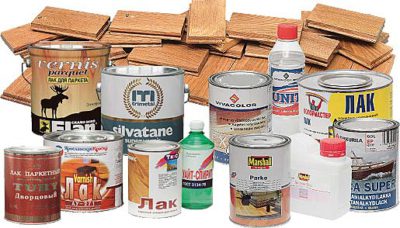
When working with alkyd varnish, it is very important to observe the norms of its consumption - no more than 120 g / sq.m, otherwise the surface may wrinkle. Do not allow direct sunlight to get on the drying surface or heat it from a central heating battery.
Anhydrous Polyurethane Varnish
Such varnishes have excellent wear resistance. They can be used even in rooms where it is customary to walk in street shoes - restaurants, cafes, theaters, etc. In addition, polyurethane-based varnishes easily tolerate the frequent effects of chemical cleaners and are not afraid of water.
When working with such a coating should carefully monitor the moisture content of the wood, it should not exceed 10%. Otherwise, the hardener may enter into a chemical reaction with water, as a result of which CO2 will be released. This will inevitably lead to the formation of air bubbles below the surface of the varnish.
Acid Curing Varnish
We can safely say that such a varnish will create the most durable coating on your floor, which is not afraid of either mechanical or chemical damage. He is not capricious about tools and perfectly fits, creating natural light shades of wood. However, when working with such material, special care must be taken:
- Mix varnish with hardener immediately before application;
- Work in a respirator;
- Provide a constant flow of fresh air into the room. Otherwise, severe irritation of the mucous membranes may occur.
Wooden floors can be painted with bright colors and applied to the surface. About the creation of an exclusive using a stencil we will tell in the material:https://floor.expertexpro.com/en/dizain/rospis-na-derevyannyx-polax.html.
Lacquer coating technology
High-quality varnishing is not easy. It is especially difficult to work with quick-drying water-soluble varnishes. They should be applied only with a high-quality roller, producing only translational movements. The varnish is applied across the board and is immediately leveled along. Thus, you varnish a surface as if crosswise.
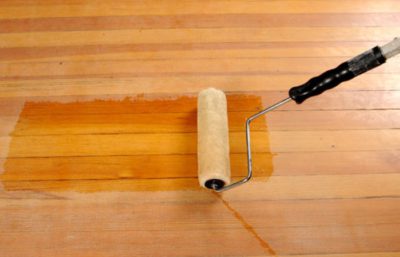
As a rule, only the first coat of varnish is applied with a spatula. This must be done with S-shaped movements quickly enough. The coating applied in this way will be more durable.
If the varnish is applied with a brush, then this is done in U-shaped movements, always slightly overlapping the previous smear. Working with single-component varnishes allows you to keep the brush in a container with varnish for short breaks. And when using a two-component, the tool must be thoroughly washed with a solvent after the end of each stage of work.
Oil technology
Oil does not form a continuous film on the floor, but is absorbed into the wood, protecting it from the inside. Such a floor will not be glossy, but its durability will please you. In addition, this product is absolutely environmentally friendly. In most cases, it does not contain solvents, and if it does, then in minimal quantities. Impregnate wooden floor oil can be even in rooms with high traffic, such as a corridor or living room. There are also oils for external use. They can be used on the wooden terrace.
Oil is much stronger than varnish shows all the flaws of wood. Therefore, the coating must be done in stages, in full accordance with the manufacturer's instructions. It is important to remove excess oil from the surface in time, otherwise dark spots will form on it. It is advisable to renew coverage twice a year - in spring and autumn.
After the first application of oil, caring for a wooden floor is quite difficult - it gets very dirty. And only after a few years, when the wood is already completely saturated, this process will be greatly facilitated. But such a floor is easy to restore, which can not be said about all other coatings. Simply sand the damaged area and soak it in oil again.
When installing a wooden floor, do not forget that the material must be protected from moisture, fungus and fire. About special protective impregnations - antiseptics and flame retardants, you will learn in the article:https://floor.expertexpro.com/en/ustroistvo-rmnt/antiseptiki-i-antipireny.html.
Wax polishing
Parquet wax is made on the basis of natural beeswax, which makes it absolutely environmentally friendly.Such a coating can be used over oil impregnation or separately.
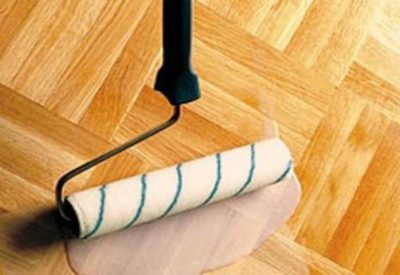
This is easy enough to do. It is necessary to apply wax on the floor, allow it to dry and polish with a cotton cloth. To renew a covering, as well as oil, it is necessary 2 times a year.
Scandinavian method of coating a wooden floor
This method is suitable for those who especially appreciate the primordial nature of natural wood and do not want to expose it to any processing. In some Scandinavian countries, sanded wooden floors are not covered with special compounds, but simply washed regularly with ordinary household soap. Over time, the wood is impregnated with a soap composition, and contaminants are easily removed from its surface.
Whatever flooring you choose for your wooden floor, remember - wood is most afraid of moisture. Even a treated and protected wooden surface should not be moistened unnecessarily. If you follow this simple rule, a wooden floor will serve you for many years. Not one, even the most advanced artificial turf, can give you so much warmth, coziness and comfort.

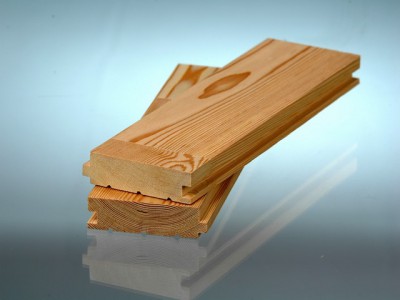

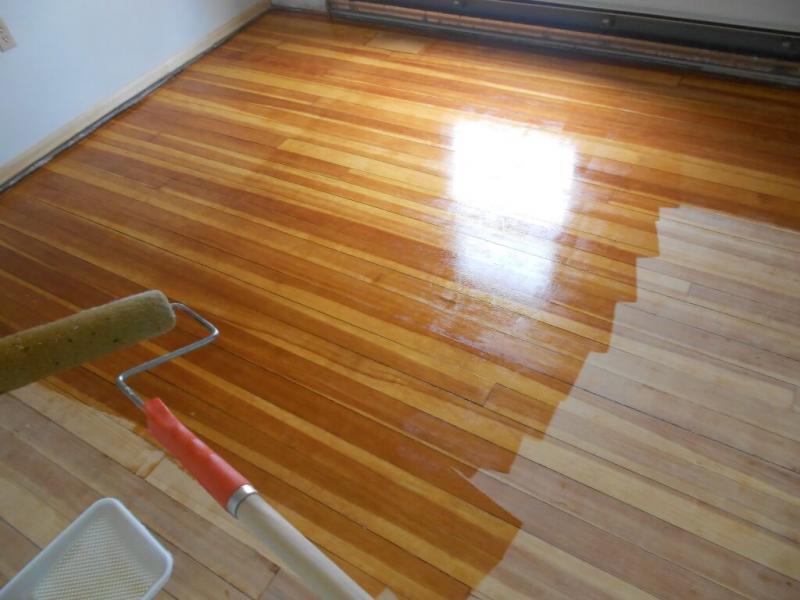
6 comments